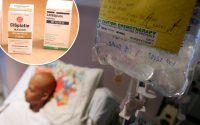Ian Reichman’s shock over stroke at 22
Ian Reichman was a 22-year-old with the world, and a soccer ball, at his feet.
Tearing around the field on a Friday afternoon in Sydney, Australia Mr. Reichman, who had always suffered migraines, began to notice his arms going numb but thought little of it at the time.
Five minutes after he walked off the ground he fell, tried to lift himself up using the right side of his body but collapsed and lost consciousness.
Mr. Reichman woke up three weeks later in Sydney’s St Vincent’s Hospital, having suffered a stroke that nearly claimed his life.
Now 30, Mr. Reichman said there was nothing physically wrong with him that suggested he was at risk of the condition.
“I had just started uni and was doing really well,” he told NCA NewsWire this week.
He didn’t smoke, wasn’t a drug user and partied within the pretty reasonable bounds of an undergraduate student.
Mr. Reichman spent four weeks in a coma, was in hospital for two weeks, was an inpatient at a rehabilitation center for nine weeks, and spent a year walking aided in general rehabilitation.
He said “there was just nothing” that could have suggested he was at risk from a stroke, and he didn’t have a family history of the disease.
Ten-and-a-half years later, Mr. Reichman, though saying he will never be “normal,” said at the age of 30 “life is good”.
He works at a disability company that works with the Australian National Disability Insurance Scheme and goes to the gym, but he still walks with a significant limp on his right-hand side and has a substantially weaker right leg.

Mr. Reichman’s experience, although unusual in a man of his age, is disconcertingly common.
According to the Stroke Foundation, more than 27,000 Australians experienced a stroke for the first time in 2020, 24 percent of whom were people under 54.
The Stroke Foundation, in its top 10 facts about stroke, said the condition killed more women than breast cancer each year and more men than prostate cancer.
Now, a new trial is hoping to shine a light on the warning signs and reduce one of the country’s biggest killers.
It’s being led by Heart Research Institute director of external affairs Ben Freedman, who is hoping the trial, which is directed at people over the age of 70, will give them a broader understanding of the simple and often harmless antecedents that are often a warning sign for stroke.
Professor Freedman said one in 10 Australians did not know they had atrial fibrillation, or an irregular heartbeat, at the time of their stroke.
He is using this fact to guide the widespread testing of Australians over 70 for atrial fibrillation through a handheld thumb device, with the aim of testing the hypothesis that more intensive electrocardiogram (ECG) screenings will reduce strokes and deaths.
An ECG screening records the electrical signals of the heart and is commonly used to detect heart problems.
“The aim of the trial is to show that early detection of AF (atrial fibrillation) will decrease the risk of stroke in this patient group and potentially lead to a national screening program for early detection of AF, just like we see with mammograms for breast cancer,” Professor Freedman said.
“AF is the most common abnormal heart rhythm and it is often asymptomatic – but early diagnosis could save your life.”
Professor Freedman said about a third of strokes could be attributed to AF, and for many there is no family history of the condition.
He said the prevalence of the condition increased with age, affecting about 10 percent of people over 70, and increases the risk of stroke by up to five times.
The trial will approach people through their GP in selected practices, and it has already begun at the University of Cambridge in the UK.
“They’ll use a novel thumb-ECG device to record heart rhythm four times a day, three days a week,” Professor Freedman said.
“Patients will be randomized to either the active screening or control arm to answer the question of whether population screening will prevent stroke,” he said.
“Once AF is diagnosed on a screening ECG, patients will be asked to visit their GP practice to discuss care and management.”
He said the explosion in consumer-led wrist-worn pulse tracking devices, such as Fitbit and Apple watches, could allow people detect the presence of AF but added there were “complexities” in how they could be interpreted by doctors.
“The issue for medical practitioners is what people are doing with those results and how they are being interpreted,” Professor Freedman said.
“They are not the silver bullet to understanding heart health.”
Professor Freedman said their results “should be treated with caution”.
“That’s why we need more research into portable ECG,” he said.
“We need to bridge the healthcare gap between consumer-led and doctor-led interventions.
“The speed at which technology is changing is amazing, but it can be a medical minefield. It’s why it’s so important we conduct this critical research.”


